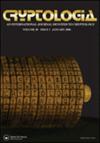1945-1960年荷兰政府电报安全的未公开历史
IF 0.4
4区 工程技术
Q4 COMPUTER SCIENCE, THEORY & METHODS
引用次数: 0
摘要
摘要1945-1960年荷兰政府电文安全背后的信息被保存在私人秘密档案馆、我国国家情报安全局和国家档案馆。因此,它变成了未知信息。本文描述了需要国家开发的安全密码系统背后的原因。但是,在国家PTT为外交部和荷兰皇家海军开发和生产otp系统背后的障碍和政治。它还揭示了将主题密码学转移到国家It行业的政治:飞利浦,1957年成为荷兰商业加密产业的开端。关键词:ecolexoberman荷兰历史每个人的时间claude shannon冷战信号军团二战披露声明作者未报告潜在的利益冲突。关于本文档中所描述的发明者我的父亲1928 - 1935 TU-Delft机械与电气工程1936 - 1957 PTT1947-1980 TU-Delft1976奥伯曼教授在他重新开始担任特别教授后在他的部门骑自行车。注1 www.cryptomuseum.com.2 PTT当时是一家国有实体,是荷兰电信行业的国家垄断者。从1946年开始,斯尼德斯在PTT与奥伯曼在密码学方面密切合作,奥伯曼最终成为代尔夫特理工大学的教授。本文章由计算机程序翻译,如有差异,请以英文原文为准。
The undisclosed history of the Dutch governmental telex-message security 1945–1960
AbstractThe information behind the Dutch governmental telex message security 1945–1960 was stored in private hidden archives, our national General Intelligence and Security Service and the National Archive. Therefore, it became unknow information. The article describes the reasons behind the need for a national developed secure cryptosystem. But also, the obstacles and politics behind the developing and the producing of the OTP-systems at the national PTT for the Ministry of Foreign affairs and the Royal Dutch Navy. It also reveals the politics to transfer the subject cryptography to the national IT industry: Philips, which became the start of the commercial crypto industry in the Netherlands in 1957.Keywords: EcolexObermanDutch historyone time padClaude ShannonCold WarSignal CorpsWorld War II Disclosure statementNo potential conflict of interest was reported by the author(s).About the inventor as described in this documentMy father1928–1935 TU-Delft Mechanical and Electrical Engineering1936–1957 PTT1947–1980 TU-Delft1976 Prof. Oberman cycling at his department after his restart as extraordinary professor.Notes1 www.cryptomuseum.com.2 PTT was in that time a state-owned entity, the national monopolist on telecom in the Netherlands.3 A. Snijders cooperated closely with Oberman on cryptography from 1946 on at PTT and he ended up as a professor at TU-Delft.
求助全文
通过发布文献求助,成功后即可免费获取论文全文。
去求助
来源期刊

Cryptologia
工程技术-计算机:理论方法
自引率
33.30%
发文量
31
审稿时长
24 months
期刊介绍:
Cryptologia is the only scholarly journal in the world dealing with the history, the technology, and the effect of the most important form of intelligence in the world today - communications intelligence. It fosters the study of all aspects of cryptology -- technical as well as historical and cultural. The journal"s articles have broken many new paths in intelligence history. They have told for the first time how a special agency prepared information from codebreaking for President Roosevelt, have described the ciphers of Lewis Carroll, revealed details of Hermann Goering"s wiretapping agency, published memoirs - written for it -- of some World War II American codebreakers, disclosed how American codebreaking affected the structure of the United Nations.
 求助内容:
求助内容: 应助结果提醒方式:
应助结果提醒方式:


